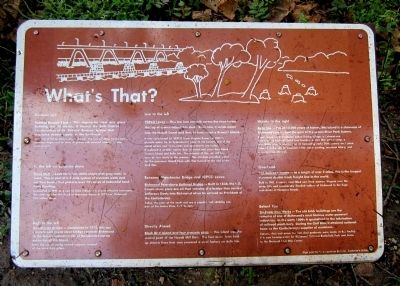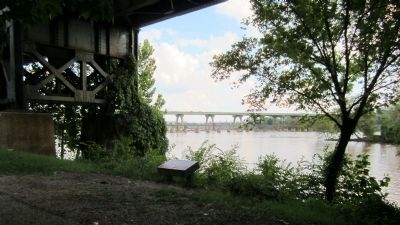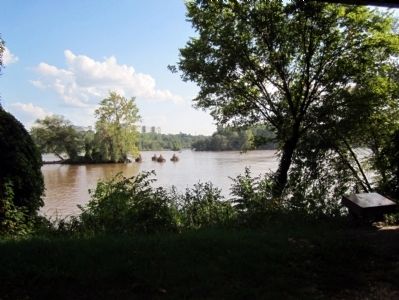Gambles Hill in Richmond, Virginia — The American South (Mid-Atlantic)
What’s That?
Extreme Left
Federal Reserve Bank — This impressive steel and glass building rises 26 stories. It houses the Fifth District headquarters of the Federal Reserve System that regulates money supply in the southeast.
Only 51% of the building is above ground. The rest, including money vaults, shooting ranges, and an army of guards with armored vehicles, is deep underground.
To the left on opposite shore
Flood Wall — Look for a low, white stripe with gray rocks in front. This is part of a 3-mile system of concrete walls and earthen berms that protects over 750 acres of industrial land from flooding.
Completed in 1995 at a cost of $135 million, it is a cost-effective investment. To clean up after the flood of Hurricane Agnes in 1972, costs Richmond $112 million alone.
High to the left
Manchester Bridge — Completed in 1972, this tan concrete and green steel bridge connects Richmond to the former industrial city of Manchester via an extension of 9th Street.
Note the use of strong arched supports instead of the usual thick pillars
Low to the left
VEPCO Levee — This low iron catwalk across the river forms the top of a once adjustable dam. Even now, it sends water into the Haxall Canal and that, in turn, creates Brown’s Island.
It was constructed by VEPCO (now Virginia Power) in 1901 to provide water for its hydroelectric plant at the eastern end of the island where new restaurants and apartments are today. It replaced a smaller, earlier dam of wood and stone that linked Brown’s Island with Belle Isle. The remains of this can still be seen at low water in the summer. This old dam provided water for the enormous Haxall Flour mills that burned at the end of the Civil War.
Between Manchester Bridge and VEPCO Levee
Richmond Petersburg Railroad Bridge — Built in 1838, the tall brown stone piers are all that remains of a bridge that carried Jefferson Davis into Richmond when he arrived as President of the Confederacy.
Today, the piers at the south end are a popular rock-climbing site, part of the James River Park System.
Directly Ahead
Black Bird Island and four concrete piers — This island was the central point of the Haxall Mill Dam. The four piers later held up electric lines that once powered a steel factory on Belle Isle.
Slightly to the right
Belle Isle — Site of 10,000 years of history, this island is a showcase of Richmond’s past – and the gem of the James River Park System.
It was the home to: a Powhatan Indian fishing village, a Colonial-era race track, a Federal Period iron foundry, a Civil War prison camp, a late 1800s granite quarry, and an innovating early 20th century steel plant. Today it is the site of excellent white water boating, mountain biking and a scenic riverside trail.
Overhead
CSX Railroad Trestle — At a length of over 2 miles, this is the longest elevated double track freight line in the world.
Built in 1901, it carries coal-filled cars from western Virginia over the steep hills and occasionally flooded valleys of Richmond to the huge coal docks at Hampton Roads.
Behind You
Tedegar Iron Works — The old brick buildings are the remains of one of Richmond’s most famous water powered industries. In the early 1800s it specialized in the fabrication of railroad machinery. During the Civil War, it attained national fame as the Confederacy’s supplier of munitions.
Cannon, shot and armor for iron clad gunboats were made at this facility. It is now headquarters fro Richmond National Battlefield Park and home to the National Civil War Center.
Erected by St. Catherine’s School.
Topics. This historical marker is listed in these topic lists: Industry & Commerce • Railroads & Streetcars • War, US Civil • Waterways & Vessels. A significant historical year for this entry is 1995.
Location. 37° 32.062′ N, 77° 26.77′ W. Marker is in Richmond, Virginia. It is in Gambles Hill. Marker is on Tredegar Street, 0.1 miles west of South 5th Street, on the left when traveling west. Touch for map. Marker is at or near this postal address: 470 Tredegar Street, Richmond VA 23219, United States of America. Touch for directions.
Other nearby markers. At least 8 other markers are within walking distance of this marker. Hurricane Agnes (within shouting distance of this marker); Gateway to the Civil War (within shouting distance of this marker); Tredegar in the Twentieth Century / Then and Now (within shouting distance of this marker); Horseshoe Shops (within shouting distance of this marker); Southern Firepower (about 300 feet away, measured in a direct line); Overshot Waterwheel (about 300 feet away); Historic Tredegar (about 300 feet away); Early Industrial Patterns (about 400 feet away). Touch for a list and map of all markers in Richmond.
Credits. This page was last revised on February 1, 2023. It was originally submitted on September 10, 2011, by Bernard Fisher of Richmond, Virginia. This page has been viewed 572 times since then and 20 times this year. Photos: 1, 2, 3. submitted on September 10, 2011, by Bernard Fisher of Richmond, Virginia.


